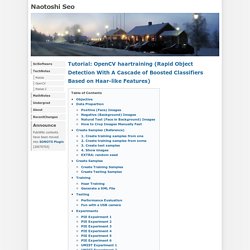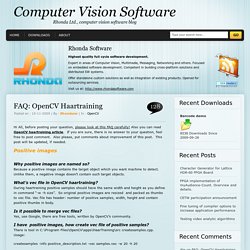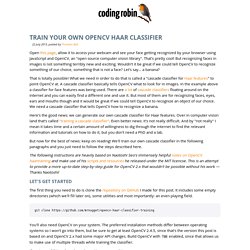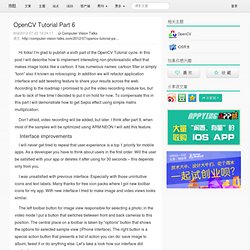

Image processing - How to define the markers for Watershed in OpenCV? Achu's TechBlog. Let us now see what is SURF.

SURF Keypoints of my palm SURF stands for Speeded Up Robust Features. Color Detection & Object Tracking. Object detection and segmentation is the most important and challenging fundamental task of computer vision.
It is a critical part in many applications such as image search, scene understanding, etc. However it is still an open problem due to the variety and complexity of object classes and backgrounds.The easiest way to detect and segment an object from an image is the color based methods . The object and the background should have a significant color difference in order to successfully segment objects using color based methods.
Simple Example of Detecting a Red Object. Opencv haartraining. Tutorial: OpenCV haartraining (Rapid Object Detection With A Cascade of Boosted Classifiers Based on Haar-like Features) - Naotoshi Seo. Tutorial: OpenCV haartraining (Rapid Object Detection With A Cascade of Boosted Classifiers Based on Haar-like Features) Objective The OpenCV library provides us a greatly interesting demonstration for a face detection.

Furthermore, it provides us programs (or functions) that they used to train classifiers for their face detection system, called HaarTraining, so that we can create our own object classifiers using these functions. It is interesting. However, I could not follow how OpenCV developers performed the haartraining for their face detection system exactly because they did not provide us several information such as what images and parameters they used for training.
My working environment is Visual Studio + cygwin on Windows XP, or on Linux. FYI: I recommend you to work haartrainig with something different concurrently because you have to wait so many days during training (it would possibly take one week). Computer Vision Software » Blog Archive » FAQ: OpenCV Haartraining. Hi All, before posting your question, please look at this FAQ carefully!

Also you can read OpenCV haartraining article. If you are sure, there is no answer to your question, feel free to post comment. Also please, put comments about improvement of this post. This post will be updated, if needed. Positive images Why positive images are named so? Image Segmentation. Pff's homepage Below is a C++ implementation of the image segmentation algorithm described in the paper: Efficient Graph-Based Image Segmentation Pedro F.

Felzenszwalb and Daniel P. Huttenlocher International Journal of Computer Vision, Volume 59, Number 2, September 2004ps.gz pdf. Tutorial: OpenCV haartraining (Rapid Object Detection With A Cascade of Boosted Classifiers Based on Haar-like Features) - Naotoshi Seo. Coding Robin. Open this page, allow it to access your webcam and see your face getting recognized by your browser using JavaScript and OpenCV, an "open source computer vision library".

That's pretty cool! But recognizing faces in images is not something terribly new and exciting. Training Haar Cascades. For better or worse, most cell phones and digital cameras today can detect human faces, and, as seen in our previous post, it doesn’t take too much effort to get simple face detection code running on an Android phone (or any other platform), using OpenCV.

This is all thanks to the Viola-Jones algorithm for face detection, using Haar-based cascade classifiers. There is lots of information about this online, but a very nice explanation can be found on the OpenCV website. (image by Greg Borenstein, shared under a CC BY-NC-SA 2.0 license) It’s basically a machine learning algorithm that uses a bunch of images of faces and non-faces to train a classifier that can later be used to detect faces in realtime. The algorithm implemented in OpenCV can also be used to detect other things, as long as you have the right classifiers. Actually, that last link is for more than just iPhones.
Similar to what we want, but since we have a very specific phone to detect, we decided to train our own classifier. Welcome to opencv documentation! — OpenCV 2.4.9.0 documentation. OpenCV 3 Image Thresholding and Segmentation. Thresholding Thresholding is the simplest method of image segmentation.

It is a non-linear operation that converts a gray-scale image into a binary image where the two levels are assigned to pixels that are below or above the specified threshold value. In other words, if pixel value is greater than a threshold value, it is assigned one value (may be white), else it is assigned another value (may be black). In OpenCV, we use cv2.threshold() function: cv2.threshold(src, thresh, maxval, type[, dst]) Algorithm - Image Segmentation using Mean Shift explained.
OpenCV Tutorial Part 6 - 推酷. Hi folks!

OpenCV 3 Watershed Algorithm : Marker-based Segmentation I. Hough Circle Detection. Cell Counting - MATLAB & Simulink Example. This example shows how to use a combination of basic morphological operators and blob analysis to extract information from a video stream.

In this case, the example counts the number of E. Coli bacteria in each video frame. Note that the cells are of varying brightness, which makes the task of segmentation more challenging. Introduction This example illustrates how to use the morphological and BlobAnalysis System objects to segment individual cells and count them. Initialization Use these next sections of code to initialize the required variables and objects. VideoSize = [432 528]; Create a System object™ to read video from avi file. filename = 'ecolicells.avi'; hvfr = vision.VideoFileReader(filename, ... Create two morphological dilation System objects which are used to remove uneven illumination and to emphasize the boundaries between the cells. hdilate1 = vision.MorphologicalDilate('NeighborhoodSource', 'Property', ... Introduction to programming with OpenCV.